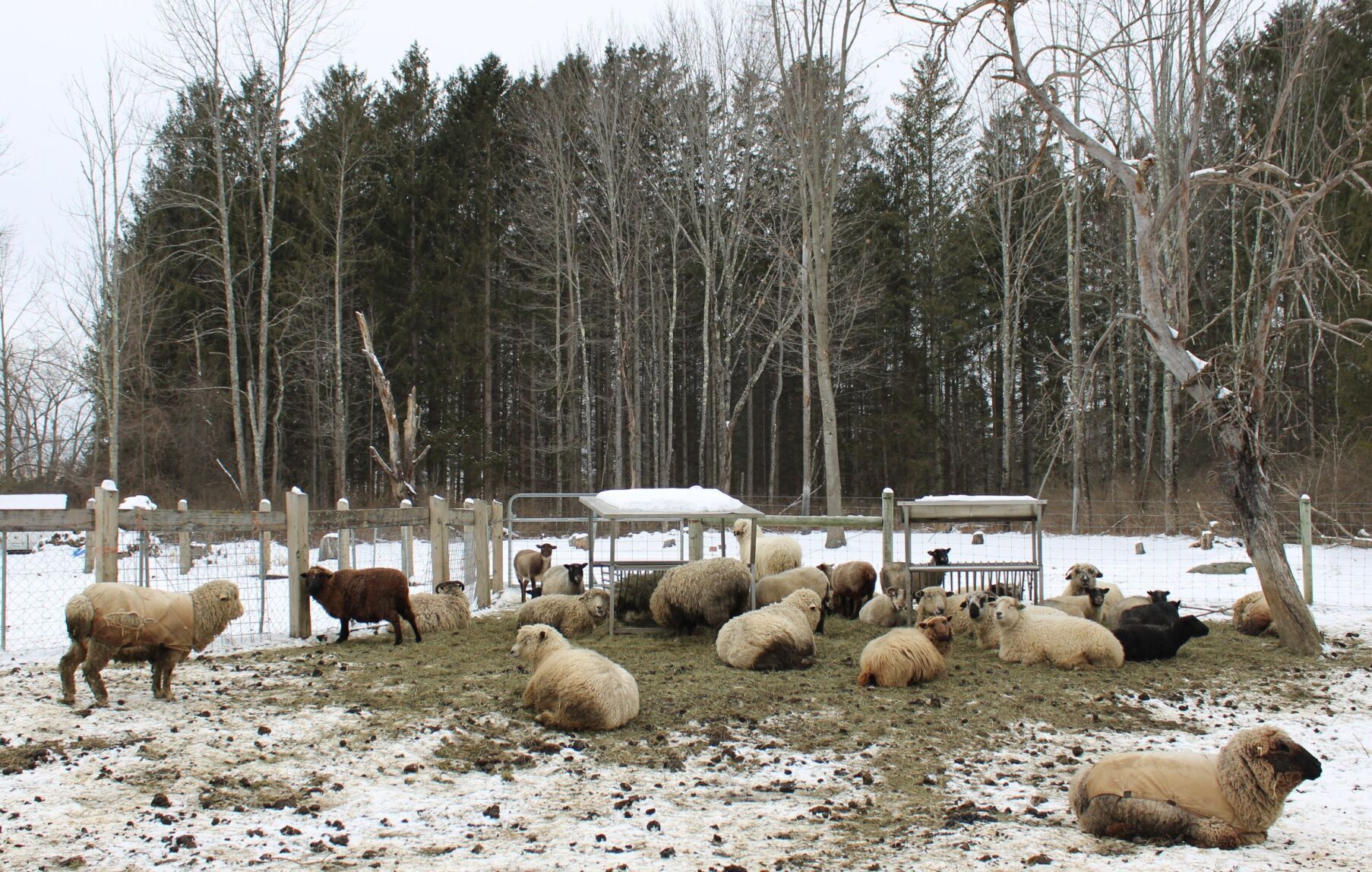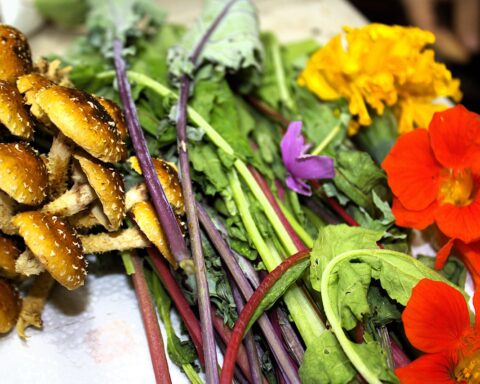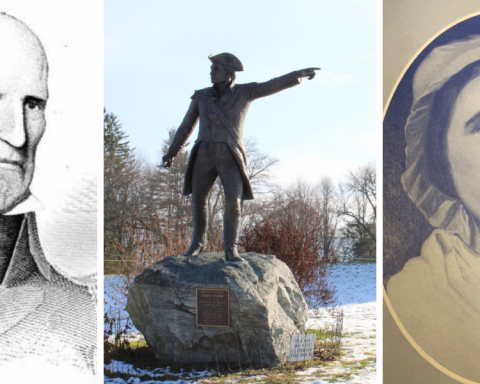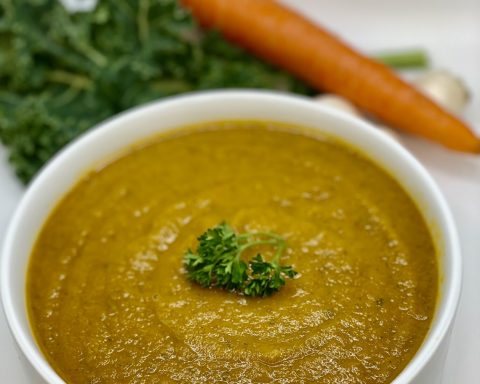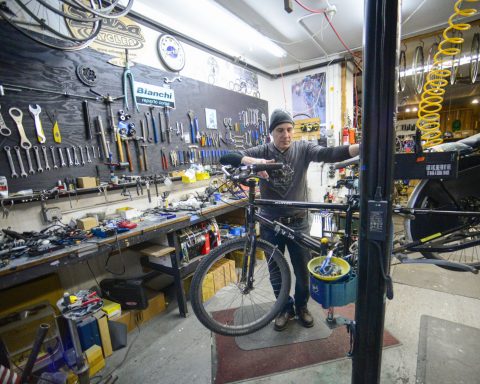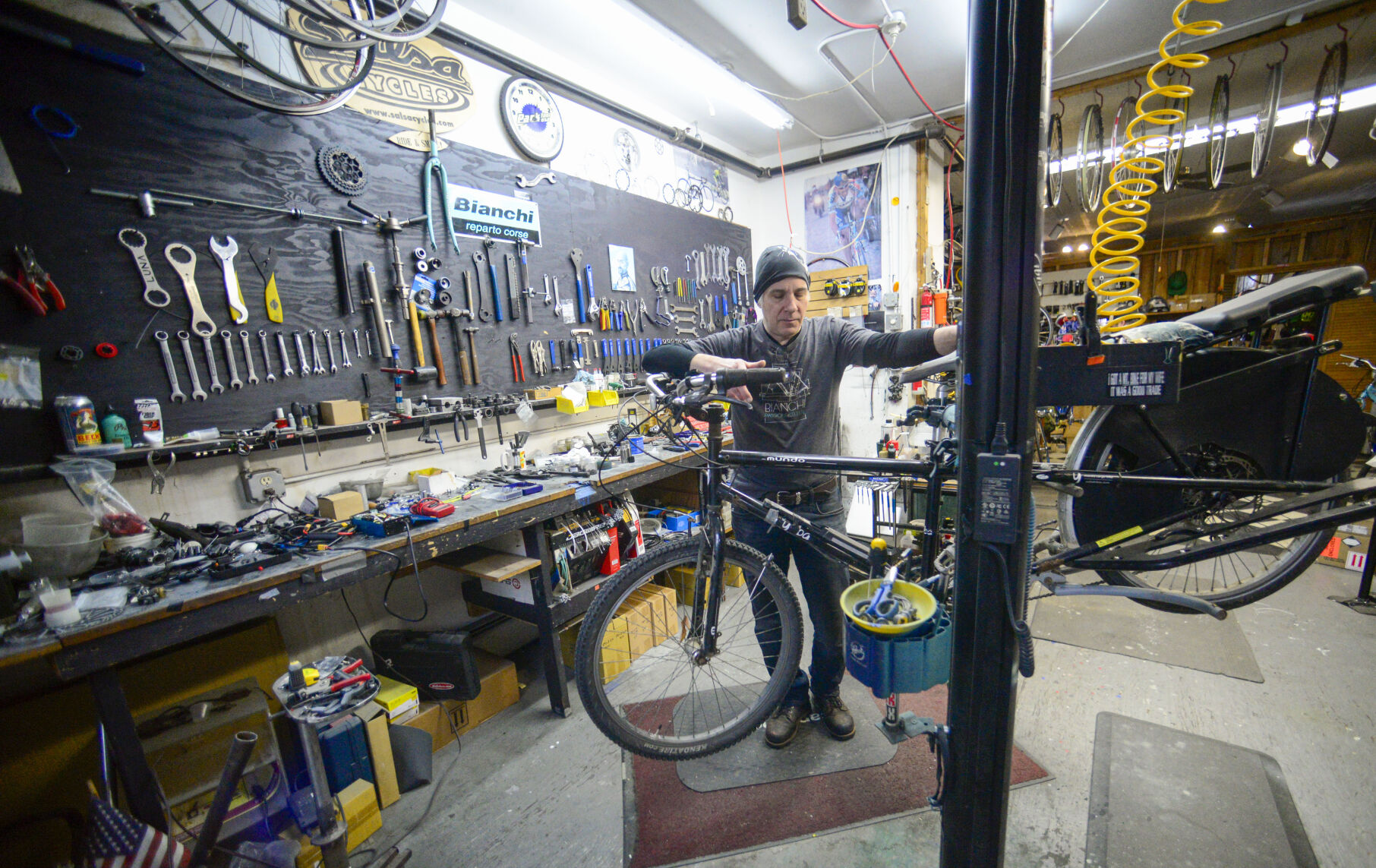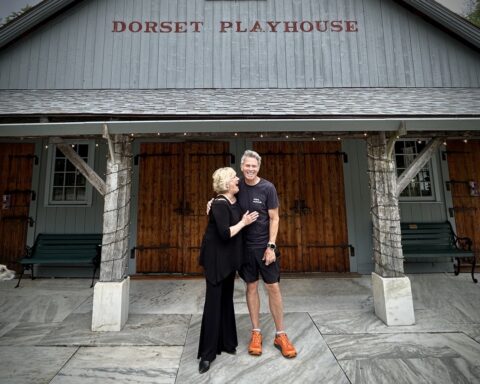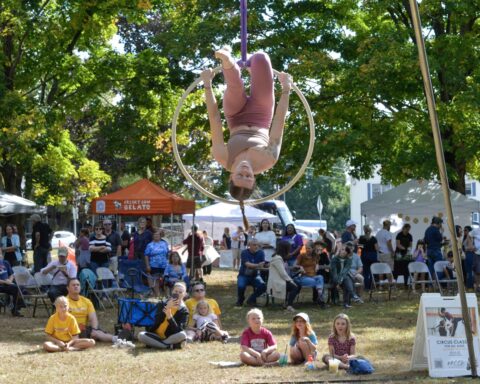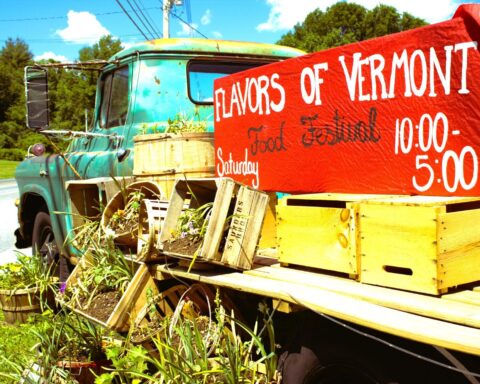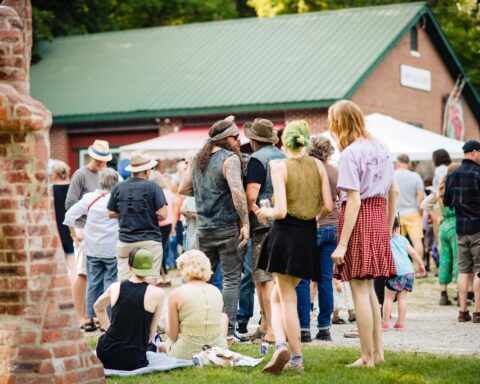By Danielle M. Crosier, Vermont Country Magazine.
SHAFTSBURY — Fiber farmer and educator Tammy White of Wing and a Prayer Farm in Shaftsbury is sitting at the old wooden spinning wheel in her home-based workshop — her feet are methodically treading the pedals; her fingers are deftly feeding the wool.
Beneath her, a lengthy trail of pale cerulean and azure fluff dangles to the floor. But, as it passes through her fingers, a stunning and variegated blue yarn winds itself onto the bobbin.
She is an artist at work.
“Spinning is my favorite thing to do. I just love spinning,” says White, enthusiastically. “Wool has these little hooks on it. If you look at the wool under a microscope, you would see that the fiber has scales, you know, and they kind of bond to each other.”
She pauses, tranquilly letting the task take over.
“So, it’s just the spinning of it, and adding tension. And, the little hooks, hook onto each other like Velcro. And, that’s how you make yarn.”
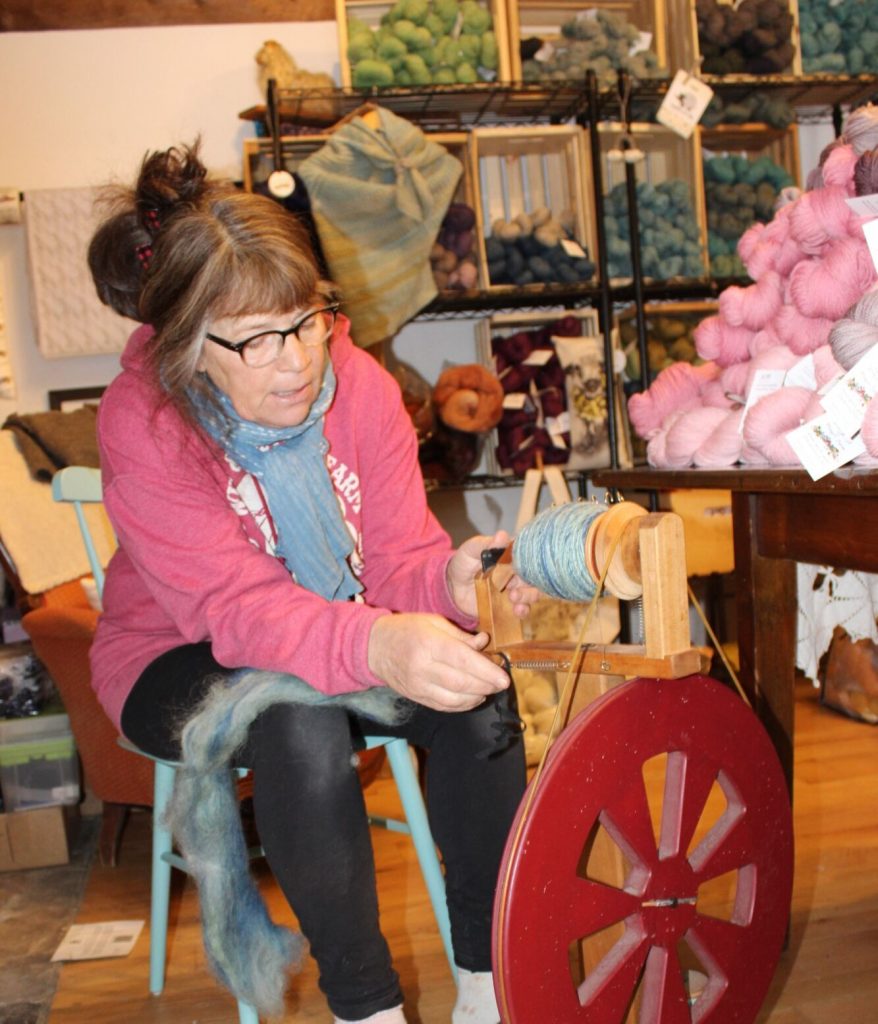
White is a practiced educator, teaching workshops on farming and shepherding, wool processing, harvesting materials for making natural dyes, and the actual methods and techniques of natural dyeing.
“Different wool has different amounts of — uh, we call it crimp,” she says, laughing, as she gently educates me.
“So, it might spin up better because it has more crimp and, if it has less crimp, it might take more to get it to hold. So, depending on what it is — like there’s Shetland wool in this and there’s Valais Blacknose — and the combination of them makes a really nice yarn. I can make a very long thin thread. The Valais Blacknose has a super long staple length. That’s what we call it, you know, when we shear them.”
White explains that the interval between shearing the Shetlands and the Valais Blacknose is about the same, but the Valais Blacknose provides much longer strands of wool, with less crimp than the Shetland. In contrast, the Shetland wool is shorter, crimpier, and very fine. By melding the two together, a soft and fine yarn with good tensile strength can be produced.
“It’s like recipes in the kitchen, but with all of my different kinds of sheep”
Tammy White
“And this is like the story of yarn — yarn, it’s like, when I spin it, it’s all about tension. So, like, at a certain point, there’s going to be enough tension that it’s going to loop on itself.”
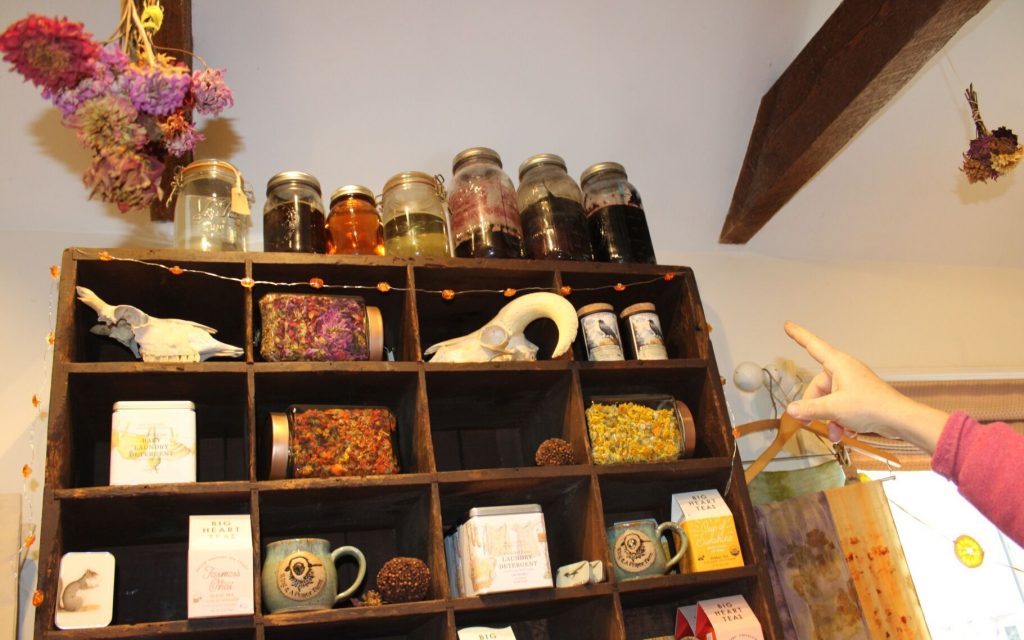
The yarn that White is currently spinning is shorn from her Shetland and Valais Blacknose sheep — and it is dyed by her as well.
White sheared the sheep, and then washed and dyed the two fleece separately — one with a fresh indigo for a greenish tint, and the other with fermented indigo for a deeper blue. She carded both fleece with the drum carder, and combed it into a batt in preparation for spinning. The batt is preweighed, so she has already calculated the weight of the skein.
“The next thing I’ll do is ply it on itself.”
One-ply is moderately strong, but two- or three-ply increases the strength and thickness of the yarn. The thicker the yarn, the greater the tensile strength.
The process of turning raw wool into skeins of yarn is complex and varied, and it is incontestable that White’s brain is spinning as fast as her wheel. There’s a subtext to the conversation, a profound comprehension of applied mathematics, physics, chemistry — not to even mention the biological sciences that make it all possible.
She’s picking and choosing what is essential information, and not trying to overwhelm. I know she isn’t dumbing it down for me, but she’s processing rapidly to find ways to explain the complexity of the production process in a tangible way and, again, I recognize the educator peeking out from behind the farmer.
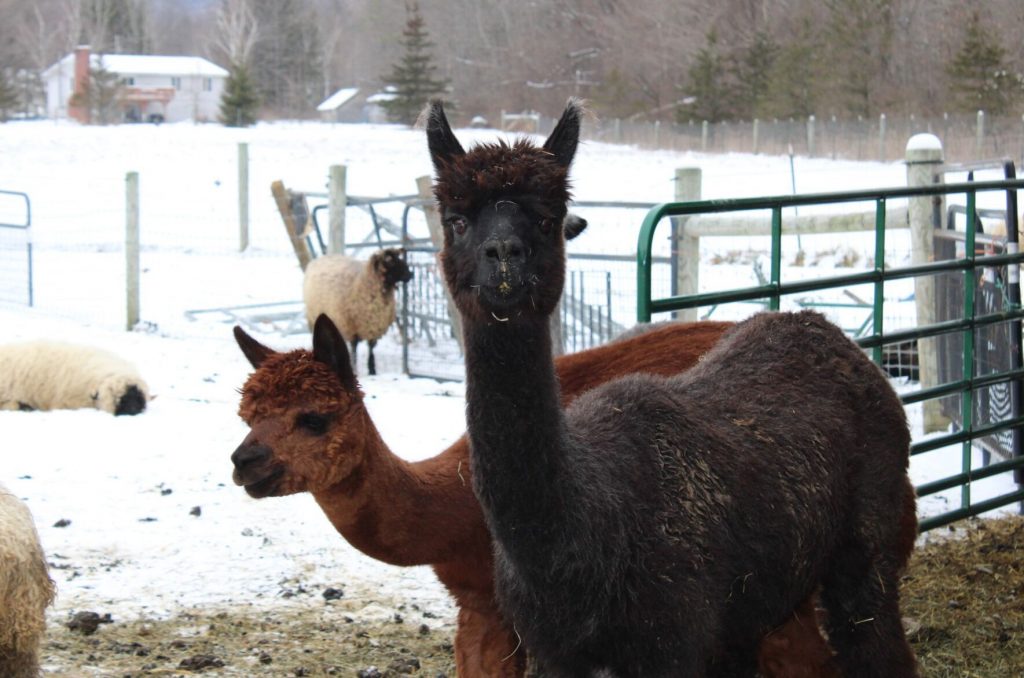
White, who raises sheep, goats, alpacas, ponies, a horse, and an assortment of cats and dogs on her small farm, also travels. She just recently returned from a trip to Boston. Soon, she’ll be headed for New York City. She’s sorting through large containers that are filled with various skeins of yarn, twisting and looping them back in a practiced twist. She’s fixing tags and taking count. She’s up and down, and all around.
And, suddenly, I’m struck with a thought — if the yarn were balls instead of skeins, she’d probably be juggling them.
As she begins bustling about her workshop — prepping orders and a donation for a local school event — White explains the ins and outs of fiber farming, raising her animals, the struggles of farming, and the art of dyeing.
“Let me tell you what’s what,” she offers, showing off her vast collection of colorful flower petals and whatnots.
“Dahlias are those red purpley ones. And those are cosmos — the cosmos are these bright orange ones. And, then, these are dyer’s chamomile, these little yellow ones. And then, way up yonder, there’s a jar of maca root and then the next one over makes a really deep purple. The next, next one over is kosha neil, which comes from these little dead beetles. It makes this beautiful brilliant pink fuchsia color.”
Most of the homemade dyes that White uses are grown in her dye garden. Madder and hopi red aramanthus, weld, marigold, calendula, indigo, woad, coreopsis, and nasturtiums — all are cultivated and harvested on the premises. In the nearby woods, she harvests for barks, leaves, weeds, lichens, mushrooms, and nuts. From the kitchen, onion peels and avocado skins. And, from the barns and sheds, rusty nails.
Her workshop is brilliant — color is everywhere. Hand-dyed yarns and textiles fill the crates and shelves against the walls. The spinning wheel sits on a fleece rug between the workbench and the fireplace, the half-spun skein of gradient blues adorning the top and the long tuft of unspun wool dangling beneath. Dried bunches of flowers and plants are hung from the rafters above. The table is littered with the tricks of the trade, orders, and more skeins of luxurious colored yarn.
The place is vibrantly alive.
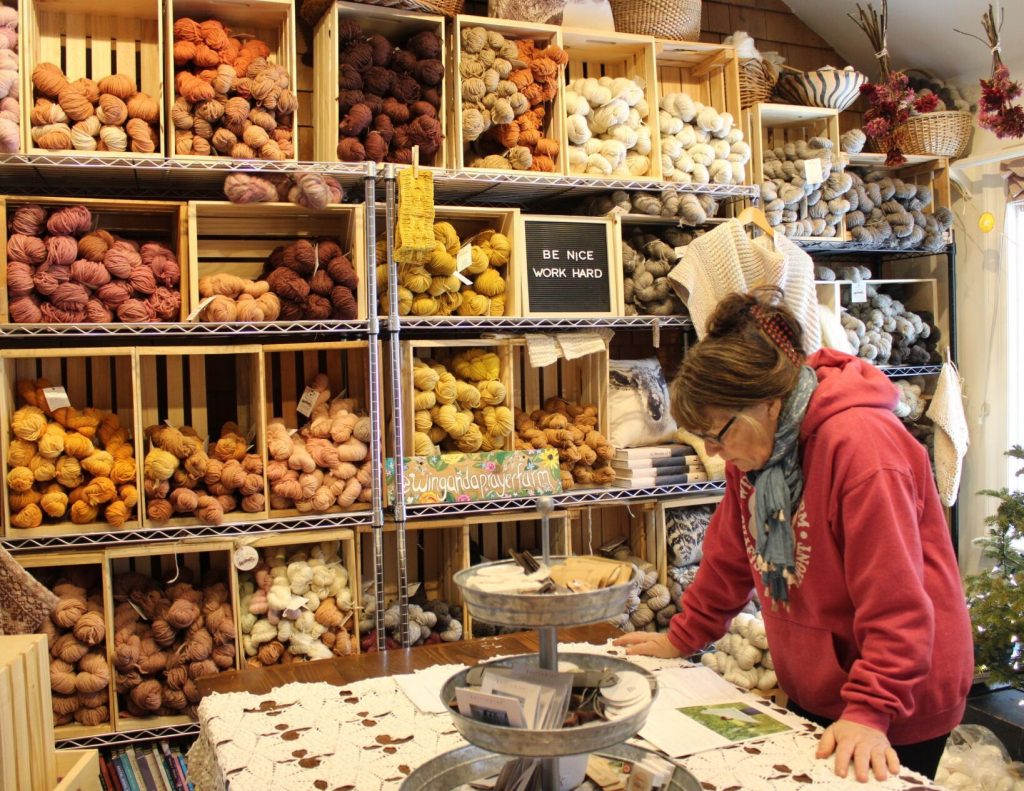
“That’s just some iron mordant that I use,” says White, pointing at yet another jar on the shelf. “I prepare the fiber with different types of things like tannins and mordants. A mordant is a facilitator. It means to bind. It helps the color from the pigment in nature to bind to the fiber.”
“There’s lots of things in nature that you can use to prepare the fiber. Like, first, I have to scour it because — if there’s any impurities in it — it could prevent the best dyeing. When you’re working with nature, you want to prep it,” explains White. “It’s super crucial.”
The process of dyeing natural fibers with natural dyes is intricate and requires an understanding of the properties, tendencies, aspects, and characteristics of both the fibers and the dyes. The preparation of the fiber material, though, is perhaps the most integral to the process. Without proper preparation of the material, the results of the dye will not be predictable or reliable.
Next, White prepares the mordant.
“I always have various stages,” she points out the vat of saturated scarves dripping from a sieve. “After I mordant them, I sometimes use tannins. Like, acorns are tannins. Oak leaves provide tannins. So, I’ll collect them in a large kettle — like this. I’ve been soaking these little shawls, scarves, in oak gall. It’s kind of gross looking. I soak them in the tannin, and then I’m going to dye them next.”
The process of natural dyeing is what White plans on teaching in New York City. First, the attendees of her workshop will learn about the properties of the fabrics that she has brought. Then, they will learn about the pre-prep. Next, they will be advised about the characteristics of the different natural dyes and about dye extraction. Eventually, they’ll get to the dyeing.
“So,” White laughs, squishing the sodden shawl material. “These are going to go with me to New York this weekend. They’re very popular. It’s always last-minute everything, you know. I have to leave Wednesday night, but probably I’ll be pulling them out Wednesday morning — and I’ll probably have them drying in my hotel room.”
The event in New York City, which is sponsored by Vogue, will be held at the New York Marriott Marquis. White, among around 50 teachers, will teach natural dyeing.
White, who describes herself as a country mouse going to the city, is feeling a twinge of excitement about the upcoming event.
“I’m looking forward to it because it will be different and fun, but I’ve taught so much and I’m very comfortable teaching. So, I’m not nervous about teaching,” exclaims White, grabbing a knitted scarf, and winding it over her hair and around her neck. “I’m just nervous about where to park my car, and things like that.”
“I’ll be vending Friday, Saturday, Sunday,” she ticks off the days on her fingers as we head to the barn through the sodden ground and the crunchy spring snow, her working dogs running and dancing raucously ahead of us. White recites her schedule as a mantra, almost to solidify the agenda in her head.
“I would rather have, you know, a lot of things happening with the farm. I’m really a country mouse in the city, I feel. And, it’s not that I don’t enjoy it — it’s kind of fun and different. It’s just a matter of not being used to it, you know? And, I enjoy the outdoors a lot, and I’m not comfortable in the outdoors in the city. I’m used to walking on grassy ground. I don’t even have a paved driveway,” she exclaims, almost joyfully, lifting a mucky booted foot up and laughing. “You know, I’m not used to pavement, so those things start to sort of give me a little bit of stress.”
Even though some of the venues give her stress, some come with their own perks.
“One of the places that I vend at, it’s in a series of greenhouses,” confides White. “It’s near Boston, and it’s just joyful to be there in January because, you know, it’s freezing outside. It’s been so cold here, and I go there, and gosh — it’s just kind of tropical and you’re surrounded by plants and everybody’s really happy — that is nice. There must be a dozen greenhouses — it’s a huge complex. And, so, we get to set up in the greenhouses — and I just love that because I get to be by all those plants.”
White speaks about the stress of being indoors all day, and not seeing the sun and the sky and the land, and suddenly wondering what time it is. When she’s on her farm, there’s a harmony she feels, with the environment — a vast connectedness.
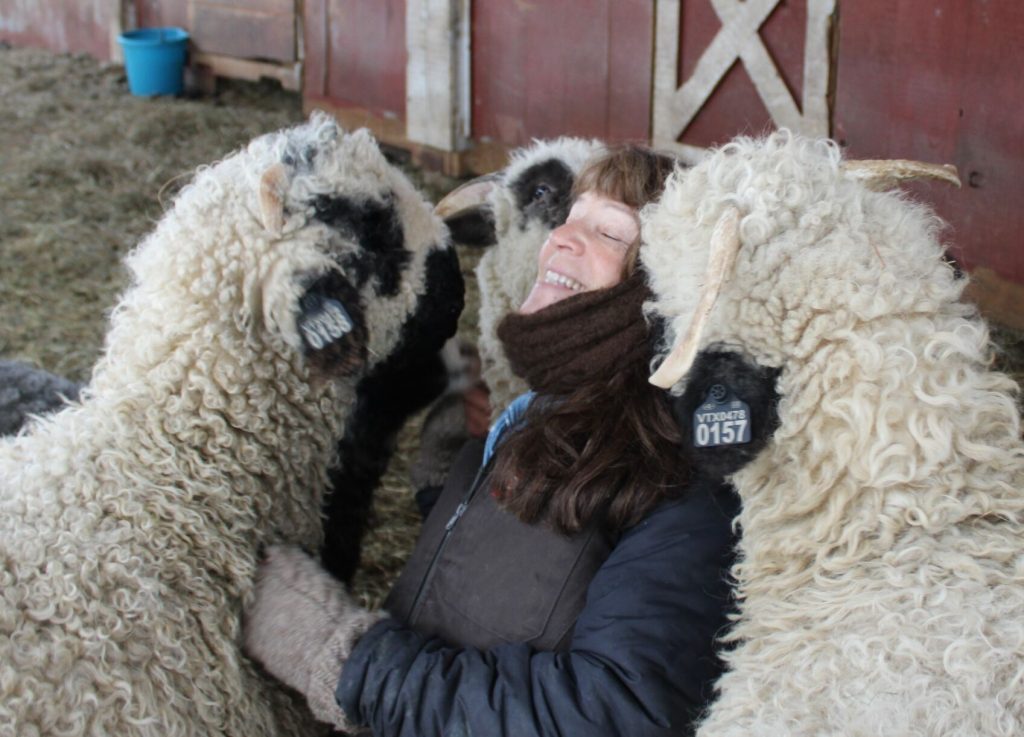
“I’m really in tune with nature,” she explains, softly. “My sheep are just walking along, gently, and they have their little hooves to aerate the soil. It’s the perfect combination of like, earth-caregiver. And they go around and they’re filling their little tums up and then they’re sitting out there so peacefully and ruminating and chewing their cud and growing this beautiful wool, and then we sear them and spin the wool and make garments to stay warm, and we can color it with pigment from nature. And, often, you see the birds, and they’re alighting on the sheep because they’re eating seeds and insects. To me, it’s so holistic. It’s not harmful to the earth; it’s helpful.”
The little woolies that she so affectionately refers to have seen and heard her coming, and they are swarming around White. She sinks down into their embrace and they nuzzle and rub and nudge and butt her. Some are so excited to see her that they can barely contain their enthusiasm. They’re literally pouncing and bouncing on their tiny hooves.
“This is Joshua, this is Josie, this is Pansy — and Peach Pie is around the corner. And that’s Pansy Junior, Greta, Eleanor, Nick Junior —” White introduces her lovies amidst their clamor for attention. “They’re my babies.”
“Are you jellie?” she cries gleefully to one, scratching him under the chin and nearly toppling over as they all jostle and bustle around her. “You’re silly. Oh no, you’re such a silly sill,” she croons endearingly. She is radiating pure joy, drinking in the love.
There is a moment of intimacy, an exhilarating joy and a great affection to this greeting, and watching feels slightly intrusive.
“Shetlands come in 11 colors,” White calls out, pointing to the Shetlands. “There’s a lot more to sheep than you would think. People think it’s just sheep. On my farm, as it is, I have eight different breeds. And each of the breeds of sheep have a fascinating and interesting heritage — and stories. It’s just like people, you know, depending on where you come from your fiber might be different, your hardiness might be different. Like, the Shetland sheep are native to the Shetland islands. There’s not trees — there’s no coverage, so their behavior is more wary and skittish generally because they don’t have a place to hide if they’re in danger.”
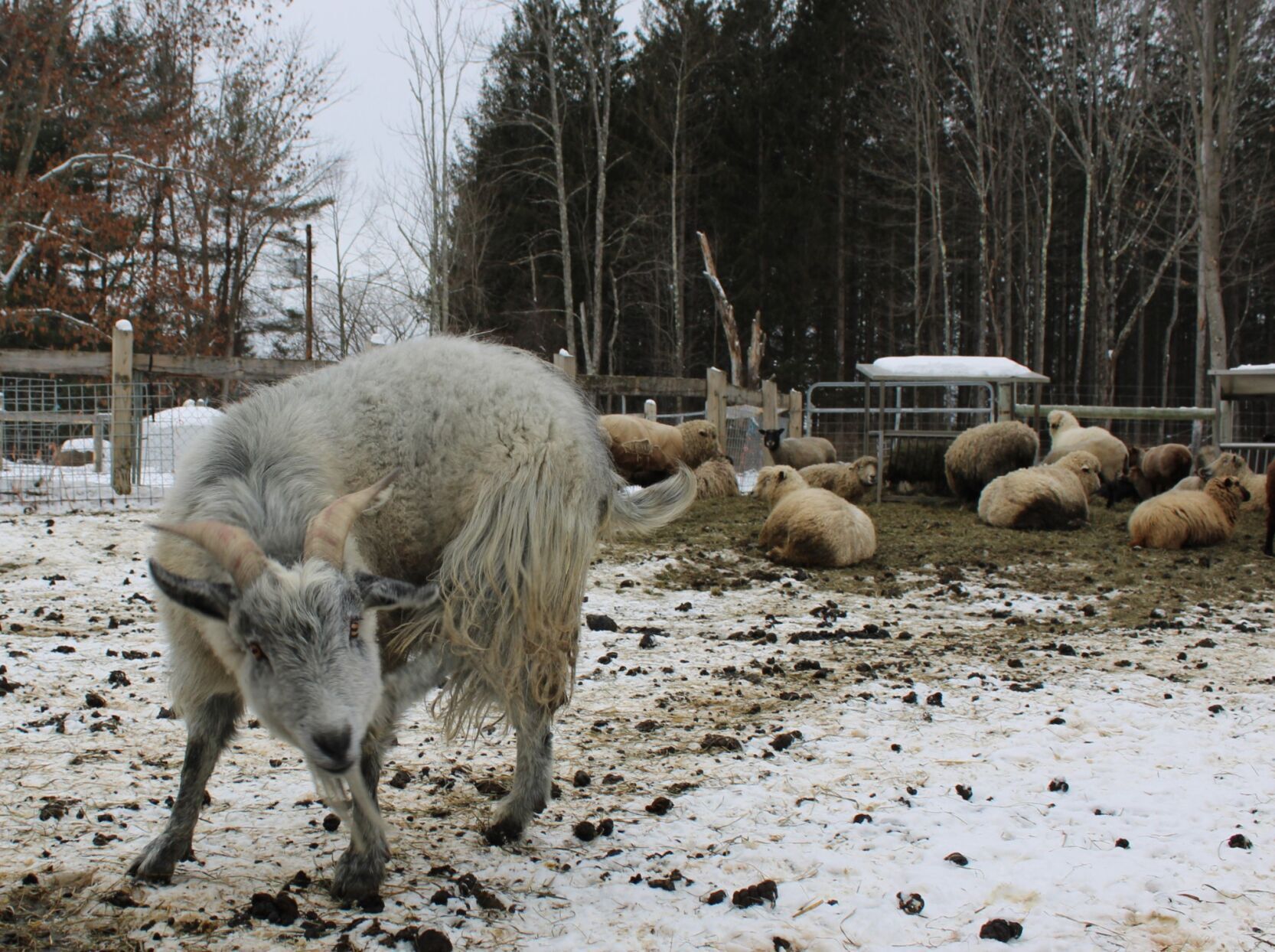
On the other side of the barn is another flock of sheep in a field with Christopher Robin, the Billie goat. There are sheep literally everywhere, and introductions begin again, “That’s Juno, that’s Drama, that’s Jubilee and Jubbee, Peach Pudding, Winona —”.
Christopher Robin is giving me the side-eye; it’s a stink eye — head lowered, and just this side of glowering. He’s sizing me up, deciding if he can take me.
“He knows you’ve got something in your pocket,” White says, grinning wickedly.
It’s a mint and, not wanting to get on his bad side, I relinquish it readily.
“Almeda is the quad queen,” White exclaims proudly, indicating a solid black ewe lounging peacefully in the straw by the alcove to the barn. “She has four babies every spring.”
Christopher Robin, meanwhile, has taken quite a hankering to the mint.
“We call them the A-Team. I give them all names that start with the letter of the mom, like Aurora, Andromeda, Athena, Angelina (she had four girls one year). Then it was Alegra, Alice in Wonderlamb, Amadeaus, Atlas. Most sheep have one or two, so for her to have four every year is kind of unusual,” says White, whose flock produces upwards of thirty or more lambs per year — most are sold to other fiber farmers or hobbyists. Some, mostly those she gets attached to, remain on the farm and join the multi-generational herd.
A horse wanders by us, ambling slowly across the lawn — free of constraints. Her name is Izzy and she spends her nights and evenings in an interior barn stall with the sheep. There are also ponies, in a pen near the sheep.
“They’re not going to defend the flock, but they’re alarmists,” says White of the ponies. “They’re like a monitor on the woods, and I always know when there’s activity going on over here. Last night, everybody was up all night and the coyotes were out, so I hardly slept last night.”
In addition to the alarmist ponies, the property is protected by a number of farm dogs and the covetous Christopher Robin. Barn cats guard the property from mouse invaders, as well. But a very real threat does come from the coyotes.
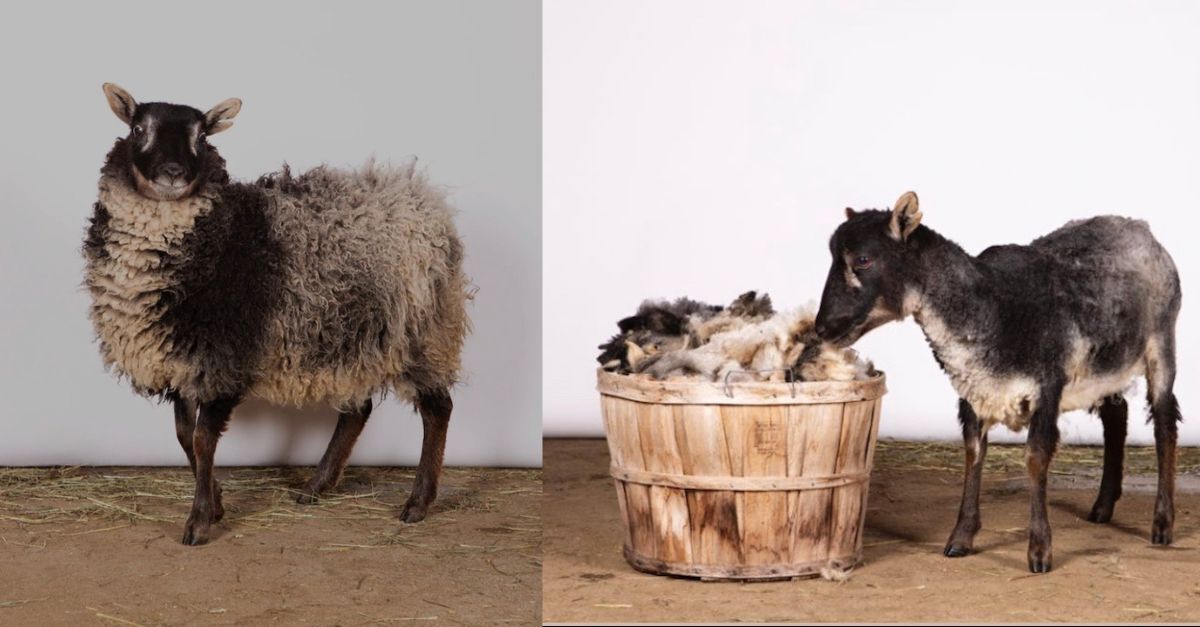
“One of my ewes, my beautiful Pippa, was lost a few nights ago,” says White, reminiscing tenderly.
She looses a deep and lengthy sigh.
“And, so, every night the coyotes have been yipping and howling and prowling around. Every night, they’ve just been so noisy and my inside dogs as well as my outside dogs are just barking all night and I can’t sleep because everyone’s up in arms about these coyotes roaming and prowling. It’s frustrating.”
The loss of Pippa was devastating for White, and she recalls her tenderly — but it is also a part of life. Where there is great love, there is great loss.
“You know, as long as you have living things, you will have dying things. I’m a very sensitive person, and very sentimental. So, having had to develop the skills to be in business — but also be responsible for all of the living things — meant that I had to reconcile and compartmentalize when things that are hard happened. It’s not that I’m thicker skinned or anything like that, but I look at the big picture of how I need to be here, and carry on.”
“They haven’t made any more kills,” she adds of the coyotes, “but it’s only a matter of time. And, I’m working on a solution — and Finn and Brady are helping me out.”
Finn and Brady are two high schoolers, neighbors, who help White out as farmhands. Today, they’re cleaning off the pond, prepping the surface for skating. A few days ago, they were loading wood and hauling deliveries.
“I’m really fortunate to be surrounded by, like, lots of good people in my life that, you know, try to help me.”
Her kids are in their early 30s and have their own lives. She’s in this alone. “They’ll help me, you know, but they’re not passionate about it like I am.”
With the sounds of the coyotes prowling the edges of the woods and the pond, and the uproar and chaos of the farm continuing unabated through the night, White is exhausted. Still, she finds her work on the farm exhilarating.
“Sometimes, I try to give myself permission to do something besides work. It’s just tricky because there’s so much to do. If I don’t do it, then who will do it? So, I might as well do it — and then, I will be — hopefully — caught up.”
This struggle is an everyday struggle for any farmer, whose daily duties involve the care of living creatures. Because White cares so much, her investment load is heavy.
“I get together with friends — we try to have a once a week commitment to get together. And, that’s really very very hard for me — not to think of it as frivolous time. It’s just that I know how good it is for me. I was talking to a friend yesterday and I said, if I could change something from the last ten years, it would be to get more sleep, White says. “It’s so good for you to get the proper rest and I just used to grind so much and say, rest later. You know, I have the rest of my life to do that.”
“You know, I have a really strong desire to keep myself physically healthy so that I can keep doing what I’m doing. And, I recognize now that I’m older and wiser, that sleep is one of the key things that will help me stay a shepherd longer.” White glances back at the troubling woods, most likely calculating how much sleep she can expect tonight.
“It’s super fulfilling to go out and view the animals — to be a part of this cycle,” explains White, almost wistfully. “And, you know, for me – because I work on it and I’m a part of this from the time that the lamb is born to the time that I’m putting a tag on the yarn. It’s just very meaningful. And, even on the hardest days, I can’t imagine a better bonus. I’m doing something so meaningful. I love the work that I’m doing here.”
Life is full of tension and stress, and farming can be the ficklest of friends.
A farmer is at the whim of nature — and nature’s truest character is that it is often brutal, and utterly indifferent to the comforts of mankind. A farmer is at the whim of the environment — and the environment will relentlessly resist constraints, and encroach on every effort of domesticity. And, a farmer is at the whim of the economy — where cries for mercy often fall on deaf ears. Farming is a gamble, even in the best of times.
But, being a fiber farmer is what drives White, she has found her truest passion in life — and it is palpable.
“I want to stay a shepherd as long as I can,” says White, gazing up at the cloud-shrouded sun and then off into the woods beyond. But, just like the story of yarn — where it’s all about the tension — sooner or later there will come a day when the tensile strength is not enough, or the yarn loops back on itself.
Today is not that day, and tomorrow isn’t either. These are good days, and White is vibrantly alive.
For now, her dedication and commitment to persevering is purposeful and — almost tenacious.
The desire to continue doing what she loves, caring and tending to her animal friends — the loves of her life — with a zeal and an ardent devotion is what brings her delight, joy, contentment, and pleasure. This, and teaching others about her passion for wool, fiber arts, color, and texture — passing on that ancient understanding of the natural world, and our place within it — they all fulfill her.
She loves this work, and she thrives here.

Danielle Crosier is a landlocked mermaid who found her way to Vermont by accident. She is a wife and mother, a former technical writer (10 years), former educator (19 years), and glass artisan with a background in marketing and strategic management. Her interests, though, lie mainly in studying and understanding systems and improving the lives of those around her. She also loves spending time with her precious children and their significant others, organizing, learning about social geography, creative endeavors, experimenting with various cuisines, and exploring the world around her.
